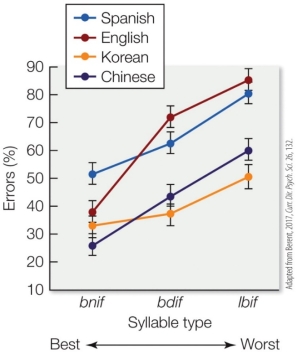Refer to the graph to answer this question. This graph illustrates sensitivity to the sonority sequencing principle in different languages. These findings suggest that
This graph illustrates sensitivity to the sonority sequencing principle in different languages. These findings suggest that
A) phonotactic constraints are learned.
B) some languages feature stronger phonotactic constraints than others.
C) there are universal biases for certain phonotactic constraints.
D) speakers of different languages have different perceptions of the same sounds.
Correct Answer:
Verified
Q29: Phonetic assimilation occurs
A) when phonemes change into
Q30: The most natural grouping of phonemes is
A)
Q31: Saffran and Thiessen's 2003 study on pattern
Q32: The different pronunciation of the plural marker
Q33: Dupoux et al.'s 1999 research showed that
Q35: How do researchers use head-turning behavior to
Q36: Discuss how Jusczyk and Aslin's 1995 methodology
Q37: Jusczyk and Aslin (1995) found that babies
Q38: Illustrate how Saffran et al.'s 1996 experiments
Q39: Refer to the figure.
![]()
Unlock this Answer For Free Now!
View this answer and more for free by performing one of the following actions

Scan the QR code to install the App and get 2 free unlocks

Unlock quizzes for free by uploading documents